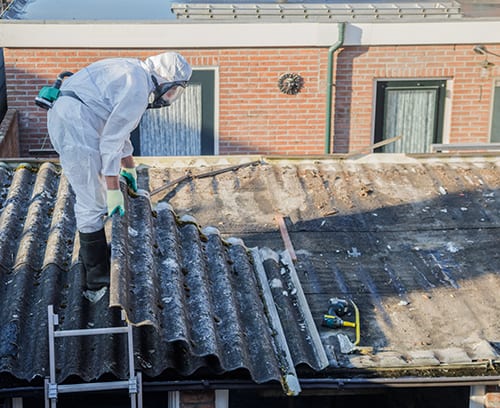 Employee well-being is paramount on any job site. That’s why it’s important for crew members to take proper safety measures when working around aged asbestos in construction materials.
Employee well-being is paramount on any job site. That’s why it’s important for crew members to take proper safety measures when working around aged asbestos in construction materials.
One of the most notorious workplace hazards in history, asbestos was once used on a large scale as an inexpensive, readily available and durable mineral. It can be found in materials such as insulation, roofing, flooring, ductwork, ceiling tiles, drywall, paint and concrete.
As these materials aged, however, asbestos became airborne in the form of harmful microscopic fibers that can cause mesothelioma, an aggressive cancer that affects organs near the chest and abdomen.
Asbestos use slowed dramatically in 1988, when a law was passed requiring manufacturers to report its use to the Environmental Protection Agency (EPA). Today, construction workers remain at high risk of asbestos exposure during renovations, demolitions and maintenance projects.
5 safety tips for working with asbestos in construction
- Do your best to find out if the job site contains asbestos. There are usually no databases tracking which buildings contain asbestos, which means building owners are often the best ones to turn to. Take extra caution with structures built before the ‘90s. The older the building, the more likely it contains asbestos.
- Take necessary asbestos training. Employers should offer asbestos training, especially on job sites where asbestos is known to exist. Workers should know how to identify asbestos materials, be aware of actions that contribute to exposure and understand the health risks. It’s worth noting that asbestos removal should only be performed by licensed professionals who understand Occupational Safety and Health Administration (OSHA) guidelines. Key takeaways include not eating, smoking, drinking, chewing or applying cosmetics in an asbestos-regulated area, as well as showering at work and leaving work clothes to be washed at work.
- Use the necessary respirator and vacuum technologies. Employers are required to provide high-efficiency particulate air (HEPA) respiratory masks and vacuums as key safeguards against inhaling asbestos fibers.
- Avoid disturbing dust when possible. This involves the use of saws, as well as working around compressed air, sweeping, shoveling and similar activities. Additionally, continually applying water (the “wet method”) while working with material can help prevent the release of asbestos fibers.
- Wear the proper protective clothing. When working with asbestos, it helps to wear full-body covering suits, gloves, face shields, head and foot coverings.
Related posts
Student housing trends for 2020 | More amenities in residence halls
Zero punch list goals | 4 ways construction crews can achieve them faster